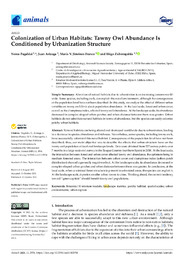Título :
Colonization of Urban Habitats: Tawny Owl Abundance Is Conditioned by Urbanization Structure |
Autor :
Pagaldai, Nerea 
Arizaga, Juan 
Jiménez Franco, María Victoria 
Zuberogoitia, Iñigo  |
Editor :
MDPI |
Departamento:
Departamentos de la UMH::Biología Aplicada |
Fecha de publicación:
2021-10-13 |
URI :
https://hdl.handle.net/11000/34895 |
Resumen :
Natural habitats are being altered and destroyed worldwide due to urbanization, leading to a decrease in species abundance and richness. Nevertheless, some species, including tawny owls, have successfully colonized this novel habitat. Consequences at the population level have not been described; thus, our main objective was to describe the effects that urban structure have on the tawny owl population at local and landscape levels. Data were obtained from 527 survey points over 7 months in a large-scale owl survey in the Basque Country (northern Spain) in 2018. At the local scale, the interaction between forest and urban cover affected tawny owl abundance, the optimum being in medium forested areas. The interaction between urban cover and clumpiness index (urban patch distribution) showed a generally negative effect. At the landscape scale, its abundance decreased in complex-shaped urban patches and when distance between them was greater. In conclusion, at the local scale, when a minimal forest structure is present in urbanized areas, the species can exploit it. At the landscape scale, it prefers smaller urban towns to cities. Thinking ahead, the current tendency toward “green capitals” should benefit tawny owl populations
|
Palabras clave/Materias:
Binomial N-mixture models
Landscape metrics
Patchy habitat
Spatial scales
Urban environments
Urban raptors |
Tipo de documento :
info:eu-repo/semantics/article |
Derechos de acceso:
info:eu-repo/semantics/openAccess
Attribution-NonCommercial-NoDerivatives 4.0 Internacional |
DOI :
https://doi.org/10.3390/ani11102954 |
Publicado en:
Animals 2021, 11(10), 2954 |
Aparece en las colecciones:
Artículos - Biología Aplicada
|

 La licencia se describe como: Atribución-NonComercial-NoDerivada 4.0 Internacional.
La licencia se describe como: Atribución-NonComercial-NoDerivada 4.0 Internacional.
.png)